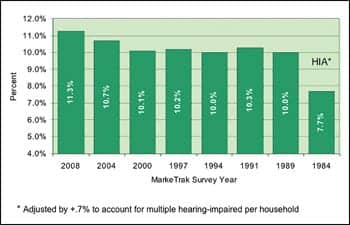Hamilton CapTel’s® 800i uses an existing phone service for the voice portion of the call, together with a high-speed Internet connection, which delivers captions on both incoming and outgoing calls.

|
| The CapTel 800i® phone allows audiologists to recommend a solution for people with significant hearing loss. With a high-speed Internet connection and an analog or digital phone line, users can read captioned transcriptions of their telephone conversations while they simultaneously listen on the line. |
Forrest J. Robinson hadn’t successfully used a telephone for nearly 20 years. A former minister residing in Winfield, Kan, Reverend Dr Robinson lost most of his hearing during World War II. Captioned Telephone (CapTel®) literally changed his life.
“Being able to use the phone is my great joy! It provides a great source of security because I live alone,” Robinson says. “I constantly tell people about the miracle of CapTel.”
Robinson is not alone. Today, one in every 10 Americans—approximately 31 million people—lives with some form of hearing loss. Often, they find everyday tasks more difficult because using the phone is problematic since they struggle to hear what is said. As a result, they become disconnected, out of touch, and separated from the daily mainstream.
In 1990, however, the Americans with Disabilities Act (ADA) spurred the development of relay and captioned telephone services. Title IV mandated that assistive technology and services be made available to those with hearing loss in any state, at any time, and, best of all, free of charge to the end user.
THE EARLY YEARS
In 2003, Hamilton Telecommunications introduced traditional captioned telephone service. This service allows users to listen to and read captions of an outside caller’s words through the use of a specially designed CapTel phone.
CapTel users can make and receive calls that are automatically captioned. Calls are directed through the captioning center, where a Captionist—who is not apparent to either party—voices the outside caller’s words. Using the latest computerized voice-recognition technology, captions are generated and transmitted to the CapTel phone display screen.
In near-real time, as the CapTel user listens to the spoken words, those words are transformed into captions on the CapTel user’s screen. The CapTel user is able to listen to the outside caller’s words while supplementing what is being heard with readable captions.
The latest CapTel technology, the CapTel 800i telephone, introduced by Hamilton CapTel in the spring of this year, uses an existing phone service (either analog or digital) for the voice portion of the call, together with a high-speed Internet connection. The phone delivers captions on both incoming and outgoing calls to a large, 5-inch caption screen that features customization to the user’s preferences. If the user so desires, captions on the CapTel 800i can be turned off or on at any point during a call.
Amplification is available up to 40 dB for captioned calls and up to 18 dB for noncaptioned calls. The phone also features instant access to CapTel customer service, caller ID capability, and an easy-to-use “Yes/No” menu system. Operating the same as a traditional land-line telephone, the CapTel 800i phone requires no additional software or downloads; all that is needed is an existing telephone line and a high-speed Internet connection.
“The independence it has given me is amazing,” says Marie Drew, who in 1975, at the age of 32, was diagnosed with a unilateral acoustic neuroma. As a result, she became deaf in her right ear and suffered facial paralysis on her right side as a result of surgery.
Ten years later, Drew was diagnosed with neurofibromatosis type 2. Her hearing slowly decreased until 1995, when she was told that her tumor was large enough to cause additional problems. Her hearing would have to be sacrificed.
Drew fought to retain her hearing. Despite multiple surgeries and her valiant efforts, she now has complete hearing loss. Although she cannot understand speech, she can hear sounds.

|
| Dr Forrest J. Robinson |
“The great thing about the CapTel is that when the other party is speaking, I usually know, and when the ‘sound’ stops, I know it is OK for me to speak,” she says. She uses the CapTel 800i phone at least once a day—often even more frequently. “I can now talk to my grandchildren without any confusion!”
Drew experienced difficulty with using a TTY. As a result, when making calls, she encountered a great deal of frustration and many of her calls were challenging and often incomplete.
Drew finds the CapTel 800i phone particularly helpful when making reservations, paying bills, or dealing with an automated “telephone tree.”
“Now, I can navigate easily,” Drew adds. “With TTY, it wasn’t even worth trying.
“The CapTel 800i phone is the best of all worlds,” she says. “I love the screen and how easy it is to enlarge the font and increase the brightness so I can see it better. I also like to look at caller ID and review my past calls. I love that the CapTel 800i phone works just like a regular phone, so people can call me directly and callers don’t even realize I have hearing loss,” Drew remarks.
She was one of the first people in the country to use the new CapTel 800i phone: “I’m a member of the NF2 Crew, an online discussion group for people with neurofibromatosis 2, and of the Association of Late-Deafened Adults, LLC, and I tell everyone about the CapTel 800i telephone. I’ve been using the CapTel 800i phone from day one!”
ON THE GO OR AT HOME
Identifying the need for a solution specifically designed for people when they’re away from home, Mobile CapTel was introduced in 2008.
Mobile CapTel allows users the freedom to go about their daily tasks outside the home, while still using captioning services for phone calls. The service is accessible anywhere in the United States depending on cellular service and coverage.
Utilizing their residual hearing to listen to the conversation through a compatible wired or Bluetooth headset, users read word-for-word captions on an Apple iPhone 3G or 3GS device. A 3G network service or Wi-Fi connection that supports simultaneous voice and data transmission is required. Soon this service will be available on a variety of devices and networks.
Traditional Hamilton CapTel provides nearly real-time captioning of telephone calls for individuals living with hearing loss, enabling them to more easily and clearly communicate with others.

|
| Shirley Adams |
“Because of CapTel, I can now talk with friends on the phone and I’m no longer cooped up or dependent upon others to make calls for me,” says Shirley Adams.
As a young girl, Adams was continually plagued by ear infections. She believes that this may have contributed to her hearing loss. It worsened in her mid 20s to the point where a regular hearing aid offered no assistance.
Because Adams’ hearing loss is at a high frequency, she received a cochlear implant in her right ear. However, she suffers almost complete hearing loss in her left ear. Having discovered traditional Hamilton CapTel through a friend who also has hearing loss, Adams has been using the service since July 2006.
“I find traditional CapTel particularly useful when making appointments, since I no longer have to drive to the doctor’s office or other businesses to speak with them,” Adams says. “Recently, my sister was in the hospital in another state and I was able to use CapTel two or three times per day to talk to her. Without CapTel, I would have been dependent on others to tell me what my sister was saying.”
INSTANT CONNECTIVITY
Early in 2008, Hamilton Web CapTel was introduced, providing mobility to those with hearing loss when using the telephone.
Using a desktop or laptop computer with a high-speed Internet connection and a standard or mobile telephone, users can place and receive captioned telephone calls from almost anywhere. Captions are displayed on the user’s computer screen, and a user can easily enlarge or decrease the size of the type font, as well as save and print captions for reference at a later date.
This service is available throughout the United States anytime—and is provided free-of-charge over a high-speed Internet connection. Long-distance charges are eliminated, and no special equipment or software is required.
Carla Vaughan works at a community center in Michigan providing recreational programs and social services to senior citizens. She estimates that she uses Web CapTel 15 to 20 times each day.
“My job requires using the phone, so it has been a tremendous help there,” she says. “I tell those with profound hearing loss that they can still make phone calls!”
She worked with Hamilton to donate a CapTel telephone to the center. For the past year, Vaughan has regularly helped people who were interested in trying the traditional CapTel service. Since there is also a computer lab at the community center, she’s worked with volunteers to help seniors set up an e-mail account, so they can also use Web CapTel, since many seniors still don’t use computers at home.
In her personal life, Vaughan uses Web CapTel two or three times a day on the weekends. She enjoys her newfound independence, as well as her ability to connect with friends and family. “Web CapTel has removed the burden of my children having to listen to my voicemails and make phone calls for me,” Vaughn recounts.
“I speak to my mother daily. I simply couldn’t do that without Web CapTel. My kids didn’t enjoy talking with me on the phone before I had Web CapTel, because they had to repeat themselves multiple times. Now, there are no more misunderstandings,” she explains.
She uses e-mail and text messaging, but feels that “it’s not the same thing as being able to talk to someone, and Web CapTel allows me to communicate on a more personal level. I would miss so much without it. In fact, I can’t use the phone anymore without it.”
Web CapTel user Donald Wright echoes Vaughan’s sentiments. “I use it primarily when I need to have a detailed conversation about something such as computer troubleshooting,” he says.
Wright has been living with hearing loss for 25 years. He began using Web CapTel approximately 6 months ago after he learned about it online.
“When I’m getting detailed information, I feel more comfortable seeing it printed out. When I needed to get specific information over the phone, I would usually ask my wife to do it. Now, using CapTel, I can do it myself,” Wright says. “I like that I can print out conversations and review them later.”
In addition to her CapTel 800i telephone, Marie Drew also uses Web CapTel. “Everyone I know who has tried Web CapTel loves it. It is so easy to carry on a long conversation while sitting back in your office chair just watching the screen.”
Drew has used Web CapTel from the very beginning and never had any problems, she says. “I can’t even imagine what it must have been like for a deaf person without these services, especially a late-deafened adult. Isolation is such a big part of deafness; at least the CapTel has helped to alleviate some of that by making better telephone contact possible.”
Frank Endres is manager of Business Development for Hamilton CapTel, Aurora, Neb. For more information about the CapTel 800i captioned telephone or any of Hamilton’s free CapTel services, visit www.hamiltoncaptel.com. Endres may be reached at (843) 236-2241 or .





